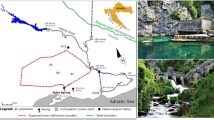Abstract
High temporal resolution (15 min) measurements of stage, pH, electric conductivity, temperature, and other hydrochemical parameters of groundwater at two sites in the Jinfo Mountain Nature Reserve of China were collected using automatic data loggers. Bitan Spring (BS 700 m a.s.l.) sits in subtropical climate zone, while Shuifang Spring (SS 2,060 m a.s.l.) is located in plateau temperate climate. The data show that hydrochemistry of epikarst springs at different altitudes is very sensitive to the changes of their physical environment, especially two factors: air temperature and soil CO2 concentration. Springs at lower altitude are associated with higher air temperature and soil CO2 concentration, thus more likely leading to more active karst processes than those at higher elevation. Water temperature and pH of BS showed a noticeable diurnal circle with high values in daytime and low values at night. The data also indicate that at least there are two effects that could impact the variations of groundwater hydrochemistry during flood pulse: dilution effect and CO2 effect.







Similar content being viewed by others
References
Chan HJ (2001) Effect of land use and urbanization on hydrochemistry and contamination of groundwater from Taejon area, Korea. J Hydrol 253:194–210
Goldscheider N, Drew D (2007) Methods in karst hydrogeology. Taylor & Francis Group, London, p 264
Grasso DA, Jeannin PY, Zwahlen F (2003) A deterministic approach to the coupled analysis of karst springs’ hydrographs and chemographs. J Hydrol 271:65–76
Groves C, Meiman J (2005) Weathering, geomorphic work, and karst landscape evolution in the Cave City groundwater basin, Mammoth Cave, Kentucky. Geomorphology 67:115–126
He S, Xu S, Zhang M (1997) CO2 concentration, hydrochemical measurement in karst soil and their relationship with karst process. Carsologica Sinica 16(4):319–324
Helena B, Pardo R, Vega M, Barrado E, Fernandez JM, Fernandez L (2000) Temporal evolution of groundwater composition in an alluvial (Pisuerga river, Spain) by principal component analysis. Water Res 34:807–816
Hess JW, White WB (1988) Storm response of the karstic carbonate aquifer of southcentral Kentucky. J Hydrol 99:235–252
Hess JW, White WB (1993) Groundwater geochemistry of the carbonate karst aquifer, southcentral Kentucky, USA. Appl Geochem 8:189–204
Jiang Z (2000) Carbon cycle of epikarst system in southern China and its ecological effect. Quat Res 20(4):316–321
Labat D, Abadiou R, Mangin A (2000) Rainfall-runoff relations for karstic springs. Part I. Convolution and spectral analyses. J Hydrol 238:149–158
Lastennet R, Mudry J (1997) Role of karstification and rainfall in the behavior of a heterogeneous karst system. Environ Geol 32:114–123
Li W, Yu L, Yuan D (2004) Researches on activity of carbonic anhydrase from soil and its bacteria in different Karst ecosystems and its ecological significance. Acta Ecol Sin 24(3):438–443
Liu Z, Groves C, Yuan D (2003) Study on the hydrochemical variations caused by the water–rock–gas interaction: an example from the Guilin Karst Experimental Site. Hydrogeol Eng Geol 30(4):13–18
Liu Z, Groves C, Yuan D, Meiman J (2004) South China aquifer storm-scale hydrochemistry. Ground Water 42(4):491–499
Liu Z, Li Q, Sun H (2006) Diurnal variations of hydrochemistry in a travertine-depositing stream at Baishuitai, Yunnan, SW China. Aquat Geochem 12(2):103–121
Liu Z, Li Q, Sun H, Wang J (2007) Seasonal, diurnal and storm-scale hydrochemical variations of typical epikarst springs in subtropical karst areas of SW China: soil CO2 and dilution effects. J Hydrol 337:207–223
Pen G, Sun Y, Teng Y (2000) Carbon distribution in Fengcong karst soil system of humid subtropical zone and its transition. Chin J Appl Ecol 11(1):69–72
Ryan MT, Meiman J (1996) An examination of short-term variations in water quality at a karst spring in Kentucky. Ground Water 34(1):23–30
Vesper DJ, White WB (2004) Storm pulse chemographs of saturation index and carbon dioxide pressure: implications for shifting recharge sources during storm events in the karst aquifer at Fort Campbell, Kentucky/Tennessee, USA. Hydrogeol J 12:135–143
Wu W, Kuang M, Wei B (2003) Preliminary study of CO2 concentration in soil in subtropical karst district of shrub. J Guizhou Norm Univ (Nat Sci) 21(2):70–74
Yuan D (1998) Contribution of IGCP379 “karst processes and carbon cycle” to global change. Episodes 21(3):198
Yuan D, Cai G (1988) Karst environment. Chongqing Publishing House, Chongqing, pp 25–29
Yuan D, Jiang Z (2000) Progresses of IGCP379 “Karst processes and the carbon cycle” in China. Hydrogeol Eng Geol 27(1):49–51
Yuan D, Liu Z (1998) Global karst correlation, Final Report of IGCP 299 “geology, climate, hydrology and karst Formation”. Science Press, Beijing; VSP Publisher, The Netherlands, p 308
Yuan D, Zhang C (2002) Karst processes and the carbon cycle, final report of IGCP 379. Geological Publishing House, Beijing, p 220
Zeng Y, Kuang M, Li L (2002) Differences in karst features at different altitudes in Jinfo mountain in Chongqing. J Guizhou Norm Univ (Nat Sci) 20(4):9–12
Zhang C, Cao J (2003) Seasonal and diurnal variation of physical-chemistry of typical springs under different vegetation—a case study of landiantang spring and dongwang spring at Nongla Village, Mashan County, Guangxi. Carsologica Sinica 22(1):1–5
Zhang C, Yuan D, Cao J (2005) Analysis on the environmental sensitivities of typical dynamic epikarst system at the Nongla monitoring site, Guangxi, China. Environ Geol 47(5):615–619
Zhong Z (1997) Progresses in vegetation ecology. Publishing House of Southwest Normal University, Chongqing, p 452
Acknowledgments
This research was supported by these projects: China Natural Science Foundation (No. 40772164), Non-benefit Institution Research Fund of the Ministry of Land and Resources, P.R. China (No. 201111022), Scientific Research Fund of the Institute of Karst Geology (No. 200703), China Geological Survey Project (No. 1212010813111), and UNESCO/IUGS International Geosciences Program Project (No. IGCP513).
Author information
Authors and Affiliations
Corresponding author
Rights and permissions
About this article
Cite this article
Zhang, C., Yan, J., Pei, J. et al. Hydrochemical variations of epikarst springs in vertical climate zones: a case study in Jinfo Mountain National Nature Reserve of China. Environ Earth Sci 63, 375–381 (2011). https://doi.org/10.1007/s12665-010-0708-y
Received:
Accepted:
Published:
Issue Date:
DOI: https://doi.org/10.1007/s12665-010-0708-y




